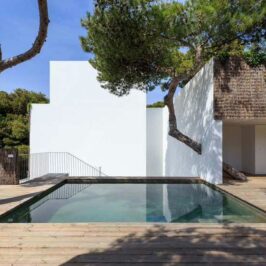For the architecture-obsessed reader, it can sometimes be tough to keep up with the publishing world. With architecture-related interests spanning from photography to philosophy, new books are released at an alarming rate and it can be difficult to spot the good from the bad. Fortunately, the good folks at Metropolis Magazine are here to help. In this article, excerpted from their list of 50 Architecture and Design Books to Read, Metropolis editors select the top architecture titles to come out this year to give you a helping hand in rounding out your reading list.
Modern Forms: A Subjective Atlas of 20th-Century Architecture
Photographs by Nicolas Grospierre
Prestel, 224 pp.
It’s often forgotten just how widespread Modernist architecture became. It could be argued that the building style was in fact far more international than its earliest pioneers could have possibly dreamed. But the dream died in 1989 (sooner in the West), with the triumph of reactionary politics and the ugly architectural aesthetics it embraced. Swiss photographer Nicolas Grospierre traveled the globe in search of the remnants of the Modernist century, capturing both the ruin and the lived-in building.
A Japanese Constellation: Toyo Ito, SANAA, and Beyond
Written by Pedro Gadanho and Phoebe Springstubb
The Museum of Modern Art, New York, 256 pp
“What began as a spontaneous response to a fast-changing urban environment would soon prompt a return to avant-garde ideals in Japan,” writes curator Pedro Gadanho of the context from which Toyo Ito, the largest star in contemporary Japan’s architectural constellation, arose. Like the exhibition it’s based on this handsome catalogue traces a lineage of sorts from Ito to Kazuyo Sejima of SANAA fame to their shared progeny—Sou Fujimoto, Akihisa Hirata, and Junya Ishigami.

Edited by Jantje Engels and Marius Grootveld
Nai010, 208 pp.
Now that the bad taste of Postmodernism has more or less worn off, it’s OK for architects to express their appreciation for history. This book, a catalogue of 45 building designs, is premised on that idea. Progressive European architects such as Anne Dessing and Bedaux de Brouwer were tasked with formulating a proposal for an addition to an existing historic building with the goal of assembling an architectural language expressive of “rooted values rather than indiscriminate forms.”
The Creative Architect: Inside the Great Midcentury Personality Study

Written by Pierluigi Serraino
The Monacelli Press, 248 pp.
This fascinating book investigates the long-thought-to-be-apocryphal 1958–59 psychological studies conducted on the nation’s top architects, including Eero Saarinen, Philip Johnson, and Louis Kahn. The examinations, held at the University of California, Berkeley, consisted of interviews and aptitude tests—several of which appear in the book. A ranking table found Richard Neutra to be the “most creative” among the architect subjects, but also placed Johnson in the top five. Which is to say, such metrics are hopelessly spotty.
Dark Space: Architecture, Representation, Black Identity

Written by Mario Gooden
Columbia Books on Architecture and the City, 128 pp.
“In several recent African American museums, the use of visual symbols to render cultural identity remains two-dimensional at best,” writes architect Mario Gooden in one of the five original essays that compose Dark Space. Gooden analyzes among other topics the form of institutions such as the National Civil Rights Museum in Memphis. In so doing, he questions, and reaffirms, architecture’s ability to critically convey black America’s rich culture.












Leave a Reply